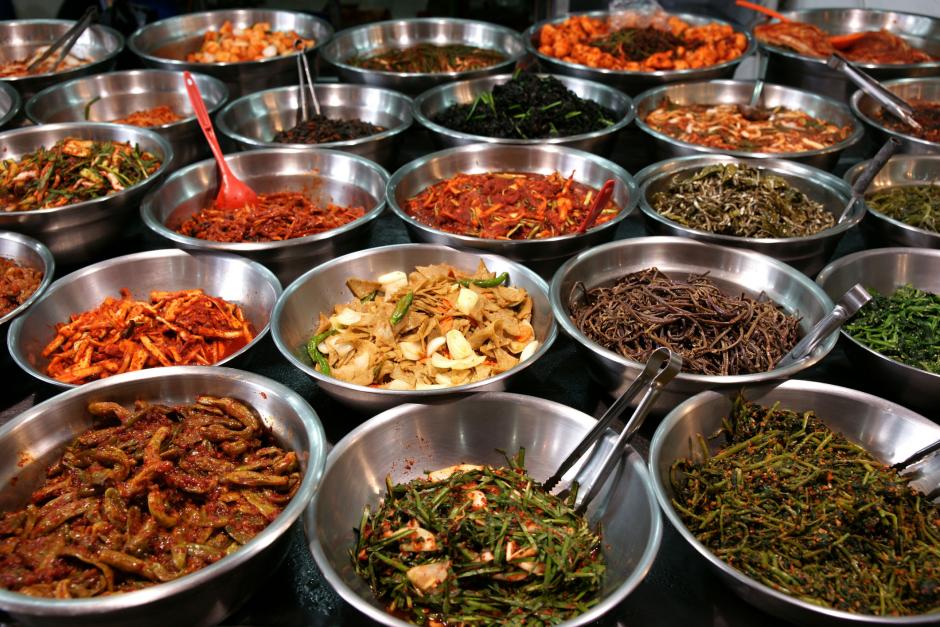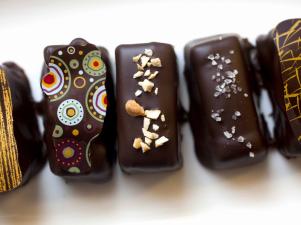Kimchi Chronicles
Korean food is not good date food. While, it’s meant to be shared, enjoyed among a group, it does not make for close, one on one physical contact. Don’t get me wrong; I love every garlicky, spicy, pickled morsel. I love not just what is eaten, but how it’s eaten; tables heavy with small cold dishes, bubbling hot casseroles and platters of meat, shared and lingered over by groups of friends, family and sometimes even business associates. But, what is wonderful to share as a group, to create or strengthen bonds really is not good for a good night kiss.
My mother swears that we Koreans by virtue of being Korean never need to worry about the odiferous remnants of a hearty Jjigae or a cool crisp Kimchi; we eat, we digest and the offending smells just disappear.
My theory? For those of us who grew up surrounded by ground chili powder, Doenjang and Cheonggukjang soybean pastes, bags of dried anchovies, jars of brine shrimp and Ziplock bags full of fresh peeled garlic, we simply don’t notice. To me my mother’s cooking is like the taste and smell of the Gods.
Now that Korean food has become more popular with sightings of foodies at my local market and neighborhood restaurant, I am on a mission to keep the food I love and grew up with as true as possible and to introduce the uninitiated or barely initiated to incredibly tasty dishes with layered flavors and textures that move beyond BBQ, cabbage Kimchi and Bibimbap.
Like most cuisines of the world, our dishes, diet and ingredients were developed for geographic reasons and influenced by outside cultures, specifically China and in the last 50 years or so, the U.S.
Kimchi was mostly likely introduced to Korea by the Chinese, pickled rather than fermented vegetables during the period of the Three Kingdoms – so long ago I can’t even do the math. Red chili was introduced sometime in the 1500’s and hence, the national dish of Korea was born.
There are over a 100 different kinds of Kimchi. The base seasonings and fermentation times may adjust slightly depending on the main vegetable, but the change from Napa cabbage to turnip greens or to radish makes a world of difference. Kkakdugi or radish Kimchi is made from cubed Korean radish or daikon; to me this takes the dish a step above the cabbage variety.
Along with the storied Kimchis buried for months in crockpots, there are a variety of quick Kimchis, like summer Kimchi. One of my favorites – made from cucumber or radish and in a vinegary cold broth with a light sprinkling of fresh ground red pepper. Not a soup by any means, though I encourage you to slurp some of the broth between bites of rice or beef or fish!
There are several Korean dishes that are a hybrid of Chinese cuisine with traditional Korean ingredients. Some of the dishes like Kkhanpunggi, a fried chicken in a sweet and spicy glaze can be found on the menus of most Korean restaurants, but the most popular can only be found at Chinese/Korean restaurants – Jajangmyeon.
It’s a wonderful noodle dish topped with a thick black soybean paste, diced pork and vegetables, sometimes, dried shrimp is added. Douse with a bit of vinegar and a sprinkle of red chili paste. Always served with pickled radish, diced onion and small side of black bean paste to dip the onion in – not to be mixed into the main dish, but to be eaten on their own.
When I was a child the first hot day of every year, my mother and I would have Mul Naengmyeon, a cold buckwheat noodle soup. The dish is served with very thinly sliced Asian pear, cucumber, pickled radish and half a hardboiled egg sitting on top of a mound of noodles floating in broth with slices of beef. Once it’s brought to the table – sprinkle in vinegar, stir in hot Korean mustard and mix it all up. Unlike soba the noodles are incredibly long, so don’t be surprised if your server whips out a pair of scissors and cuts into them! I like to take my Kimchi, dip it in so the red spice of the Kimchi mixes in with the vinegary broth. This dish is the ultimate taste of summer – cool, slightly sweet with wonderful crunchy textures.
How about some pancakes? Yes, it’s true we have pancakes, savory rather than sweet. The standard is Pa Jun or Pa Jeon, a wheat and rice flour based pancake with green-onion as it’s primary ingredient, pretty much anything can be mixed in, but the most popular additions are seafood and Kimchi. The best are thin and crispy served with a dipping sauce. The classic dipping sauce for many Korean dishes; soy sauce, vinegar, red chili flakes, toasted sesame seeds, a splash of sesame oil and green onion.
The other pancake, which is much harder to find on restaurant menus, is Bindaedok. It was my favorite as a child. My mother would make it regularly. Then one day when I was about 10, she stopped. Years later, I asked her why. She said it was too much work. I’ve never figured that one out. It’s made with a batter of ground mung beans. Seriously, how hard is it to throw some mung beans into a blender and press puree?
Okay, maybe I’m making it sound too simple, after all there is a tiny amount of rice flour added into the batter. Traditionally mung bean sprouts and sour kimchi are mixed in, but ground pork or beef can also be added. Also, served with the classic dipping sauce. These pancakes are smaller than Pa Jun, a little denser in texture with a more delicate flavor. They are outstanding!
I can’t write about Korean food and not include soups and stews. We have a wide variety from hearty and spicy filled with vegetables, seafood or beef to milky rich broths sprinkled with green onions.
Duk Mandu Guk is a beef broth soup filled with mandu, a beef and pork dumpling, rice cake, green onion, shredded egg and garnished with toasted seaweed. I add a healthy dose of black pepper and always dip my Kimchi into the thick broth. It’s comfort food at its best, but most importantly it is the dish we eat to bring good luck every New Year - that would be lunar New Year. We follow the Chinese calendar on this one.
The tradition of eating Duk Mandu Guk on New Year’s is so ingrained that when my son and his girlfriend became vegetarian, I panicked. Terrified of what evils and bad luck would fall upon them if they didn’t have a bowl of this soup. Fortunately, they found a Korean restaurant here in DC that serves up a vegetarian version. It gave me inner peace -I felt as if all was right with the universe.
The better-known stews are Jjigaes, specifically Kimchi Jjigae. Kimchi Jjigae is how every Korean household makes use of Kimchi that has become too sour or overly fermented to eat on its own. There is no soup base used in this – the broth is simply water, dried anchovies and the liquid from the Kimchi. Beef or pork is added as well as green-onions, red pepper, tofu and garlic. It’s a lighter stew, layered flavors, but at its core a simple dish. I also highly recommend seafood Jjigae or one of my favorites, cod roe. So, along with your BBQ try one of these Jjigaes – I promise you will not be disappointed!
Other Jjigaes are made with a fermented soybean paste, the ingredients are simple, tofu and vegetables, often sliced Jalepenos or other hot peppers added. These Jjigaes are richer, heavier and depending upon which paste is used as the base, even for a Korean, the smell can be overwhelming.
I am going to end this post with the most outstanding American contribution to Korean cuisine, Spam and hotdogs. During the Korean War when food was scarce, many Koreans were able to get canned ham, Spam and hotdogs through Army facilities. Yes, we embraced them all and as a child I remember my mother making Jjigaes with Spam, hotdogs and bacon.
Her version was a more streamlined version of Budae Jjigae, Army Stew. The classic version of this dish has spam, hotdogs, macaroni or dried ramen noodles, Kimchi, sometimes canned baked-beans and whatever fresh vegetables are available all cooked up in a broth made of Gochujang (a soybean paste made with red pepper) and water.
Budae Jjigae is still wildly popular in South Korea. For those really courageous give it a try. I can attest to the fact that Spam cooked in Korean spices and Kimchi make it far more appealing and tasty. It even makes you stop asking the eternal questions – “what is Spam, anyway?”
I could go on forever about the tastes and dishes of Korea, but I am out of time and space. My best advice is next time you have a hankering for Kalbi or Bulgogi, get a healthy size group together, go to your local Korean BBQ restaurant and try a new dish or dishes. Experiment, eat like a Korean, keeping in mind we never eat BBQ alone, it’s part of the meal, not the whole meal; we’re always ordering a Jjigae or a soup to share. So, think outside the box a little, be adventurous and if you’re truly afraid, you can invite me to dinner and I’ll do the ordering!
---
This month we invited East Coast Trendscaper, Ann Vogel, to share her wisdom about Korean Food. Enjoy her guest post and insights before you order Kalbi or Bulgogi. Ann is a Korean-American always on the look out for Korean food that meets her mother's standards and the president of Ann Moorehouse, Ltd.— a creative marketing consultancy based in Washington DC. Connect with her on LinkedIn.




